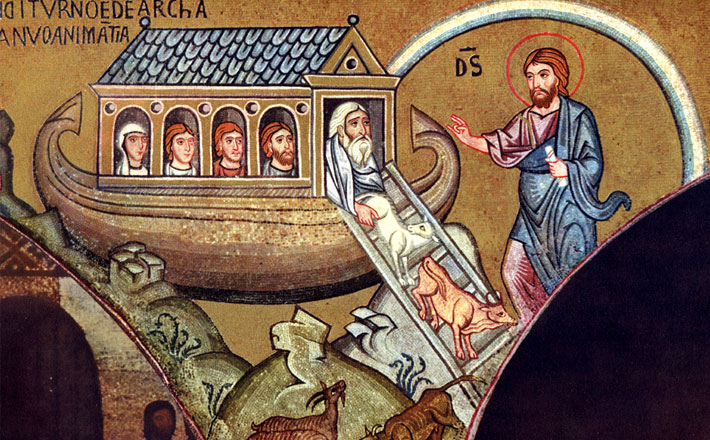Commentary on Mark 1:9-15
Just what’s going on out there in the wilderness, anyway?
It’s a fair question, because Mark devotes only two verses to the occasion. Congregations may be familiar with the three tests the devil puts before Jesus in Matthew 4 and Luke 4, but Mark’s version remains striking for its brevity and mystery.1
The Holy Spirit and the larger battle
Although today’s gospel reading includes Jesus’ baptism in Mark 1:9-11, I won’t comment much on those verses since they were the focus just a few weeks ago, when churches observed the Baptism of the Lord. Because the Revised Common Lectionary always assigns a Testing in the Wilderness narrative to the first Sunday in Lent, I will spend most of my time with those verses.
Still, we should not miss the fact that it is the Holy Spirit who initiates the scene, putting Jesus into the setting where he must contend with Satan. The Spirit forcefully compels Jesus there, indicated with the verb (ekballo, “drove out” according to the NRSV in 1:12). The same verb appears elsewhere in Mark, when Jesus exorcises unclean spirits from harassed people. This Holy Spirit possesses Jesus, having entered “into him” at his baptism (the NRSV drops the ball by translating en as “on” in 1:10).
Jesus goes into the wilderness, then, as a player in a larger drama. His first role is to face a formidable adversary. Although later he will characterize his work as adversarial to Satan’s “kingdom” and as an effort to plunder Satan’s “house” (Mark 3:23-27), early on in Mark 1 we might be forgiven for mistaking Jesus as a weapon used in a war between other, superior forces or as a new recruit who still needs to prove his mettle.
The wild beasts and a promised transformation
Nevertheless, Mark’s account doesn’t explicitly indicate whether Jesus successfully passes his test, although the subsequent verses, in which he announces the advent of God’s “kingdom” (1:14-15), suggest he prevails. The other Synoptic Gospels concern themselves with Jesus’ faithfulness in the wilderness. Mark uses the occasion instead to provide intimations of what God will accomplish through this Spirit-endowed Jesus.
At least two details warrant our attention.
First, after only thirteen verses, we see that this gospel aims to paint Jesus’ ministry as confrontational. He has come to combat and perhaps defeat forces determined to counteract God’s intentions for human well-being. The first extensively narrated incident of his public ministry in Mark will be an exorcism (1:21-28, which the Revised Common Lectionary assigned three weeks ago). The narrative location of the parable about a thief “tying up the strong man” (3:27) suggests it serves as a mission statement for his entire ministry. The antagonists in Mark are not human ignorance and religio-political authority; they are spiritual forces, things that oppress human bodies and minds and defy human attempts to subdue them. The world Jesus inhabits is a dangerous place.
Second, something about Jesus’ experience in the wild, out in a boundary setting at the threshold between civilization and untamed places, is supposed to capture our imagination. Served or protected by angels, Jesus is “with the wild beasts” (Mark 1:13). Just what’s going on out there in the wilderness?
Our answer will depend on what other biblical texts we have in view.
One perspective says that Mark evokes hopes of a restored or new creation coming into being. If the wild beasts pose no threat to Jesus, if he sleeps with his head on a lion’s back and with a Komodo dragon alongside him for warmth, then creation — at least this outpost within it — has been transformed. It is (again?) at peace with itself. Through Jesus, as a result of victories he will win over powers of chaos and destruction, harmony will come to earth.
That reading of Mark 1:13 considers the verse alongside Hosea 2:18, in which God pledges to make a covenant with “wild animals” (theria in the LXX, the same term as in Mark 1:13) so Israel can “lie down in safety” and experience peace. Other “peaceable kingdom” texts, such as Isaiah 11:6-9, also support such an interpretation.
Another perspective interprets Mark 1:13 as demonstrating God’s provision for Jesus, reassuring readers that God will not leave God’s “Beloved Son” entirely vulnerable to the ravages of the world. In this reading, wild beasts have not been made safe; rather they are kept at bay so Jesus enjoys protection.
This reading of Mark 1:13 keeps an eye on Isaiah 35:8-10, which promises a highway (a holy “way”; cf. Mark 1:2-3) for God’s people to travel as they return from exile. God makes this way safe, for no dangerous animals are there (here, too, the LXX uses theria, in Isaiah 35:9). Another eye may be on Ezekiel 34:23-31, in which God raises up a new David as a shepherd-king and banishes the wild animals (theria in LXX Ezek 34:25, 28) from the land.
Mark 1:13 may tell about a transformed creation made harmonious, or it may hold out the promise of keeping at bay all the still-dangerous elements of creation. In either case, the imagery contains a sense of reconfigured boundaries. Old rules and expectations no longer apply in the same way when Jesus is present. Other passages will confirm this with respect to religious practices (e.g., Mark 2:18-22), and Jesus’ healings will repeatedly confound our sense of what’s possible. The empty tomb in Mark 16 will make this point even more forcefully.
The reign of God and a risky ministry
With Satan having been confronted and perhaps served noticed by the Spirit-possessed Jesus, with wild animals having been made unwilling or unable to prey on the vulnerable, and with John’s public ministry having been terminated by a reckless and arrogant puppet king, now the time is right.
At this time, beginning in Mark 1:14, Jesus begins to proclaim the in-breaking of God’s reign (or “kingdom”). To speak of a “reign” means to characterize Jesus’ ministry as announcing the realization of God’s intentions for humanity and all creation. Jesus’ focus is temporal, not spatial. That is, he announces the dawn of a new era and a new state of affairs, one in which God rules; with the expression kingdom of God he does not speak of taking people away to a new place in a far-off land. He tells those who listen that God is bringing new realities into existence; Jesus himself demonstrates what these realities look like through his actions and words.
This “reign” is about more than people’s spiritual existence. Jesus will call people to new understandings about what all of life is like. Family, society, political allegiances, economics, wellness, purity and acceptability — no facet of life remains unaddressed.
Perilous beings dwell also in places other than the wilderness. And the in-breaking reign of God does not curb them all at once. The time may be “fulfilled,” but it remains dangerous. As we will see by the time Lent concludes, and as we walk through Mark’s Gospel from now until November, Jesus’ way of living out his purpose is dangerous, too. The late theologian William Placher put it this way about Mark 1:14-15: “What Jesus is beginning is the transformation of this world. That is why those in charge of this world as it was ended up killing him.”2
Notes:
1 In all these scenes, “test” is probably a better translation of the Greek verb peirazo than “tempt.”
2 William C. Placher, Mark (Belief: A Theological Commentary on the Bible; Louisville: Westminster John Knox, 2010), 35.


February 22, 2015